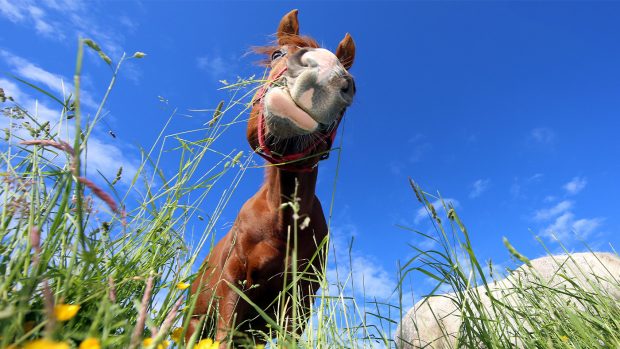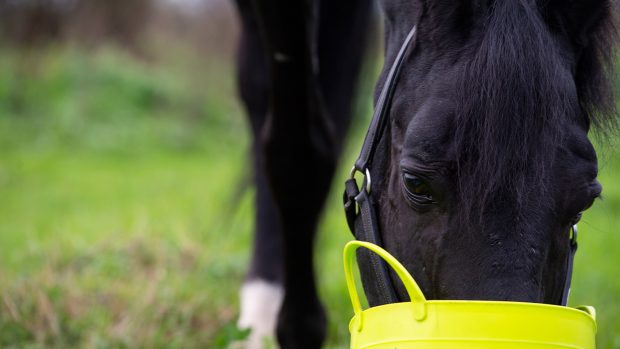Navigating feeding terminology can be hard to digest at times. Andrea Oakes sifts through the latest offerings on the market to find the true meaning behind those feed company phrases.
- Antioxidant
- Balancer
- Broad-spectrum supplement
- Electrolyte
- Energy-dense formula
- Extruded pellets
- Full-fat soya
- Macro and microminerals
- Mash
- Muscle builders
- Mycotoxin binders
- Nucleotides
- Pre-digested feed
- Probiotics and prebiotics
- Superfibres
- WSC
Antioxidants
These immune system boosters can prevent cell damage, but do all horses need them?
According to Saracen Horse Feeds senior nutritionist Lizzie Drury, the rate of a natural bodily process called oxidation increases if horses have a heavy workload or are used for breeding. “This ‘oxidative stress’ results in an increase in free radicals — damaged cells that go on a rampage to damage other, healthy cells,” she says. “This can lead to decreased immune function, illness or increased muscle soreness.
“Antioxidants are substances such as vitamins, minerals and plant extracts that help to slow down and prevent free radical damage. They’re most abundant in fresh green pasture, but some horses may not have access to plenty of this. Provision of antioxidants through concentrate feed or with additional supplements is very important for horses considered to be under extra stress.”
Balancers
Feed balancers are the modern way to provide key nutrients that may be lacking in a largely forage- or pasture-based diet.
“They contain a balance of nutrients — including protein, carbohydrates, amino acids, fatty acids, vitamins and minerals — to meet a horse or pony’s daily requirements,” says Spillers nutritionist Clare Barfoot.
“They’re designed to be fed alongside forage and deliver a negligible amount of energy, or calories, making them ideal for good-doers.”
Broad-spectrum supplement
This term refers to the wide range of micronutrients (vitamins, minerals, trace elements and yeasts) within the vitamin and mineral supplement, rather than indicating that it is aimed at a wide range of horses.
Electrolytes
Electrolytes are salts, which are essential to bodily functions and lost through heavy sweating.
“Most horses on a balanced diet, comprising quality feed and forage, and in light to moderate work will receive sufficient electrolytes to meet daily requirements,” says Briony Mitchell of Baileys Horse Feeds.
“Any potential shortfall can be made up by adding one to two tablespoons (25-50g) of table salt daily, or providing free access to rock salt.
“Requirements can be dramatically increased, however, for horses exercising over longer periods, or working intensely — especially in hot weather. We recommend that horses who sweat regularly should receive an electrolyte supplement to replenish lost salts and aid recovery.”
Energy-dense formula
“Sometimes it is necessary to pack a lot of calories into a small space, which is what ‘energy dense’ means,” says TopSpec nutrition director Nicola Tyler. Feeds for weight gain tend to be energy dense.
“These products are most often used when a horse is working hard and needs a lot of calories, but is close to his ‘meal size limit’ — the amount of food that will comfortably fit in his stomach.”
Extruded pellets
Extruded feed is pressure-cooked with steam before being pushed through a die and cut into shapes, such as pellets.
“Wet-steam extrusion is a highly controlled process allows the right temperature to be reached with minimal nutrient degradation,” says Louise Scott of Keyflow Feeds, adding that dry-steam extrusion can degrade or destroy certain nutrients. “The digestibility of the feed is raised by up to 90%.”
Full-fat soya
Soya beans (sometimes called soybeans) are frequently listed among feed ingredients. The “full-fat” version, found in some of the Chestnut Horse Feeds range, for example, describes the use of the whole bean, without any oil extraction. The beans are extruded to produce a high-quality meal that is rich in protein and oil but low in starch.
Macro and microminerals
Essential minerals can be divided into two groups.
“Macrominerals, such as calcium, phosphorus and magnesium, are needed for body structure, maintaining fluid balance, nerve conduction and muscle contraction,” explains Briony Mitchell.
“Microminerals (sometimes called trace minerals) include copper, zinc and selenium. They’re required in smaller amounts but are no less important, playing a vital role in the control of a large number of biological reactions.”
Mash
You’ll find various mashes on the market — such as Keyflow Pink Mash — which differ from the more traditional hot bran meal.
Modern, quick-soaking mashes can be mixed with cold or lukewarm (never hot) water to create a palatable feed for fussy eaters or veterans who struggle to chew. It’s easier to stir powders or supplements into these soakable feeds, plus they can also aid rehydration.
Muscle builders
To develop muscle, a horse needs amino acids — which are the building blocks of protein. So the “muscle builders” referred to in some Connolly’s Red Mills balancers refer to a mixture of amino acids.
“While a healthy horse can make ‘non-essential’ amino acids, the ‘essential’ ones must be provided in his diet,” says Louise Jones, a senior nutritionist for Connolly’s Red Mills. “If you feed a quality protein, from a source such as soya, you’ll be providing a good blend of both.”
Mycotoxin binders
These feed additives are designed to eliminate any mould toxins that could be in the horse’s diet, either in the hard feed or forage.
“They’re useful for high-performance athletes, to help eliminate any natural toxins that could be limiting performance even slightly,” explains Gain nutritionist Chris Miller.
Nucleotides
They may sound like something from science fiction, yet feeding these molecules as part of a balancer can aid metabolic processes and improve overall recovery rates.
“Nucleotides act as precursors to the proteins that repair damaged tissue and muscle,” says Emma Nicholls of Blue Chip. “They help to increase the length of the intestinal villi [the tiny, finger-shaped projections lining the intestine] to improve nutrient absorption. They also boost red blood cell turnover, so that more oxygen can be transported around the body.”
Pre-digested feed
Put simply, pre-digested feed has been cooked.
“Cooking untangles the nutrients and effectively begins the digestive process,” says Louise Scott. “This allows easier digestion and maximum absorption in the small intestine — the process by which nutrients pass through the intestinal wall into the bloodstream.”
Probiotics and prebiotics
Confused about which is which? Louise Jones explains: “Probiotics contain live bacteria, essential for a healthy gut, while prebiotics basically provide food for these ‘good bacteria’.”
Where digestive health is a concern, Louise suggests choosing a feed that contains a blend of yeast and prebiotics. Probiotics may be necessary for animals that are young, old, sick or stressed.
Super fibres
These highly digestible fibres include sugar beet pulp and soya bean hulls.
“They can be used as good, safe energy sources for horses,” says Chris Miller. “This distinguishes them from poorly digestible fibres, such as cereal fibres, that yield relatively little energy.”
WSC
You’ll find water-soluble carbohydrate (WSC) in hay — it’s basically the sugar content of your forage.
Depending upon your horse’s health and his susceptibility to conditions such as Equine Metabolic Syndrome and laminitis, you may be keen to cut down the amount of sugar he receives.
“Soaking hay does decrease WSC levels, but it is not a consistent process,” says Becky James of Haygain. “Losses can range from 9-54% after a 16-hour soak, plus soaking can cause a two- to five-fold increase in bacterial content. Steaming hay also causes a variable drop in sugar content, but it does kill bacteria and moulds.
“If you need to limit sugar intake from hay, the best option is to find high-fibre hay, steam it and send a sample to a laboratory for WSC analysis.”
You might also like:

Understanding probiotics: your complete guide

How are feed balancers different to vitamin and mineral supplements?

Subscribe to Horse & Hound magazine today – and enjoy unlimited website access all year round
Horse & Hound magazine, out every Thursday, is packed with all the latest news and reports, as well as interviews, specials, nostalgia, vet and training advice. Find how you can enjoy the magazine delivered to your door every week, plus options to upgrade your subscription to access our online service that brings you breaking news and reports as well as other benefits.




